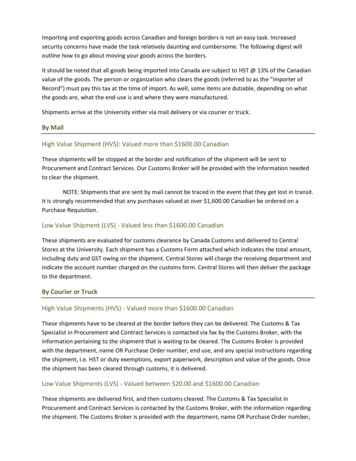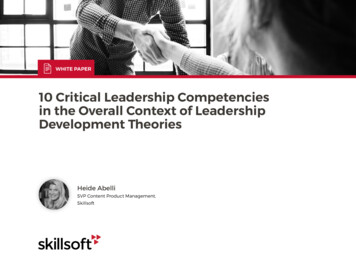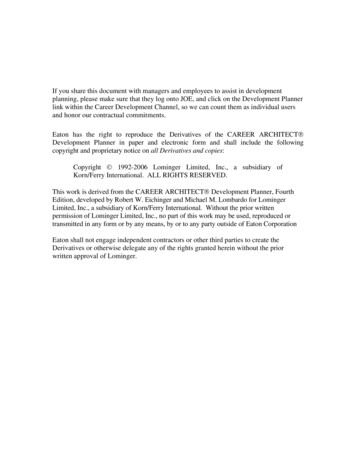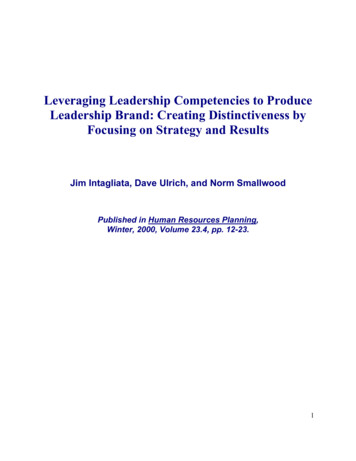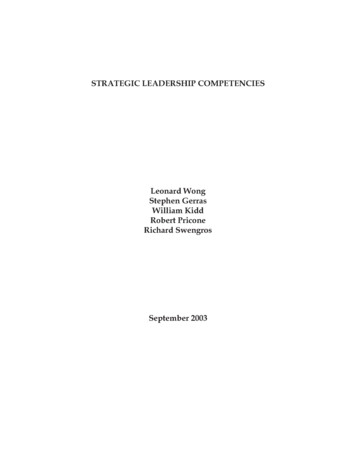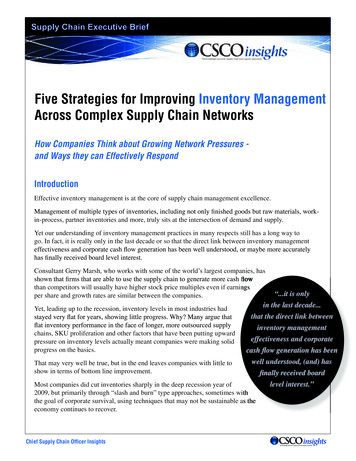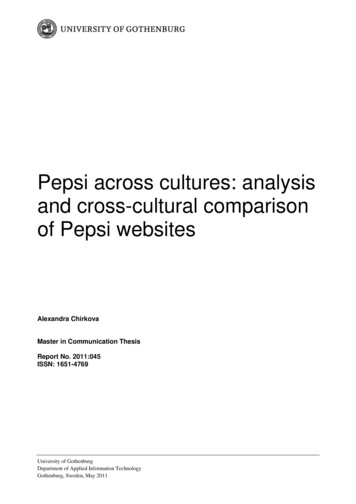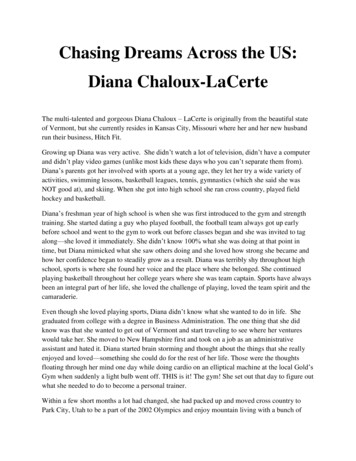
Transcription
The leadership competencies valuedacross cultures: getting things done.Worldwide, people appreciate leaders of any cultural background if they deliver results.
Getting things done IntroductionEngineering re-engineeredIt has become an article of faith among businessexecutives across the globe that the leadershiptechniques that work in one culture won’t necessarilybe effective in another. While some cultures valuethe hard-charging, demanding leader, employees in adifferent culture might resent a boss who fails to buildconsensus among the staff. Workers raised in one culturemight be seen as reluctant to highlight problems andsetbacks for fear of punishment, while those in anotherexpect to be praised for speaking up.But that faith should be tested.While certain leadership skills are deemed moreimportant for success in specific cultures, someleadership competencies are universally endorsed,especially when it comes to getting things done.Every culture wants the leaders of its organizationsto get results.Tweaking leadership approaches to fit any specificculture doesn’t require wholesale changes to the basicbusiness culture, but is more a matter of nudging localbelief systems in the direction of this emerging coreset of leadership values.1Globalization of businessand business educationcreates workplace culturesthat are becoming moresimilar to each other.
Getting things done Leadership convergence.As globalization has expanded business across theworld at an increasingly rapid pace, executives haveDue to globalization and convergence of thought,contemporary organizations are beginning to adopt along assumed that leadership and management stylesneed to be significantly adjusted for the customs,beliefs, and values of the local workforce. That iscorrect—to a degree. More than a decade ago, researchrevealed that people in different cultures possessdifferent assumptions about the personal attributesand behaviors of effective leaders (Bonnstetter, 2000).For example, people who are considered effectiveleaders in Anglo-oriented cultures tend to be moreparticipative than human-oriented, while the oppositeis true for people in Confucian Asian cultures(House, Hanges, Javidan, Dorfman & Gupta, 2004).“universal corporate culture” in which all members of theorganization, regardless of their own national culture,have similar work values and beliefs that guide businessinteractions. This trend seems obvious, because, nomatter where a business is operating, the day-to-daymanagement challenges, business problems, and goalsare very nearly universal (Gentry & Sparks, 2012).As business becomes more and more international,however, so does business education and leadershiptraining. Consultants and business schools from Westerncountries have expanded their offerings into Easterncountries, while managers from the East are increasinglyattending programs in the West. At the same time,business schools are standardizing and formalizingmanagement training into fewer, more distinct models.So while specific characteristics in workplaceinteractions continue to differ in how they’re valued,interpreted, and received in any one specific culture,management goals, values and techniques areconverging into one global set of values. It should comeas no surprise to any savvy business executive that,regardless of the etiquette or preferred communicationstyle, no culture on the planet values or celebrates theleaders of any organization that consistently producesshoddy products or regularly loses money.2
Getting things done Leadership divergence.Nonetheless, culture does play a role in leadership.The divergence perspective suggests that nationalculture drives the formation of values and beliefs morethan commonality based on cross-national businessand globalization. As a result, the respective views andbeliefs of members of organizations will, for the mostpart, remain unchanged by the spread of business andglobalization. Even with evidence of globalization and arise in the number of organizations that are expandingand increasing their cross-national operations,employees from different cultures still retain work valuesand beliefs that are consistent with their respectivenational cultures. The challenge is how to tweak theseconverging leadership and management techniquesSmall Power Distance vs.Large Power DistanceIndividualismvs. Collectivismto fit specific cultures. In this way, recognizing andadjusting leadership techniques is more a question oftools and strategies to adapt those techniques whilecontinuing to emphasize the core leadership valuesneeded to achieve the organization’s goals.Where culture matters.There are five distinct aspects of national culturesthat leadership researchers take into account whenconsidering the differing responses to leadershipcharacteristics. As defined by Hofstede (2010), thedimensions of cultural styles are: How less powerful members of the culture accept and expectthat power will be distributed unequally Small power distance cultures value equalizing the distributionof power and demand justification for inequalities Large power distance cultures accept a hierarchical order Whether the self-image in a society is defined as “I” or “we” Individualism emphasizes loosely knit social frameworks whereindividuals care for only themselves and their immediate families Collectivism includes tightly knit social frameworks where groupmembers exchange care for unquestioning loyalty Described as “tough” versus “tender” culturesMasculinity vs.Femininity Masculine cultures value competition and achievement orientation,including heroism, assertiveness, and material success rewards Feminine cultures emphasize consensus, cooperation, modesty,caring for the weak, and quality of life Weak uncertainty avoidance cultures value practice over principlesWeak UncertaintyAvoidance vs. StrongUncertainty Avoidance Strong uncertainty avoidance cultures maintain rigid codes of beliefand behavior and dismiss unorthodox behavior and ideas A culture’s degree of comfort with uncertainty and ambiguity, andwhether people attempt to control or accept the unknowable future Degree of emphasis on short-term vs. long-term thinkingLong-Term Orientation vs.Short-Term Orientation3 Long-term orientation cultures maintain traditions and norms,and are suspicious of change Short-term orientation cultures approach change pragmaticallyand emphasize preparation for an unpredictable future
Getting things done Different, but the same.The idea of “different, but the same” is illustrated bythe simultaneous divergence and convergence acrosscultures in leadership styles, as seen in a recent studyof results across cultures of 360 feedback ratings,where employees receive anonymous ratings frommanagers, peers, and direct reports and providetheir own self-ratings (Tang, D’Mello & Dai, 2017).The link between culture and competencies was exploredusing Hofstede’s (2003) model of cultural dimensions.Conceptually relevant leadership competencies wereCultural Dimension14identified for four of the five cultural dimensions.1For instance, masculine cultures prefer achievement,heroism, assertiveness, and material rewards forsuccess. Behaviors such as drive for results, actionoriented, career ambition, and command skillswould be leadership skills considered important inmasculine cultures. In contrast, feminine culturesprefer cooperation, modesty, caring for the weak, andquality of life. Feminine cultures would support orcultivate leadership behaviors such as understandingothers, listening, compassion, and work/life balance.Competency ClusterHigh Power DistanceManaging up Political savvy Comfort aroundhigher management Boss relationshipsLow Power DistanceEgalitarian Approachability Delegation Fairness toward direct reports Developing othersCultural DimensionCompetency ClusterMasculinityAchievement Drive for results Action-oriented Career ambition Command skillsFemininityEmpathy Understanding others Listening Compassion Work/life balanceIndividualismPersonal influence Standing alone Conflict management Managerial courageHigh UncertaintyAvoidanceMeticulous Priority setting Planning Process managementCollectivismCommunion Peer relationships Building effective teams Interpersonal savvy Caring about direct reports Personal learningLow UncertaintyAvoidanceThe competency library used in this study was revised to the current 2016 Korn Ferry Leadership Architect(KFLA; Korn Ferry, 2016). See the Appendix for a mapping of the original competencies to the 2016 KFLA.Spontaneous Dealing with ambiguity Dealing with paradox
Getting things done In both masculine and feminine cultures, competenciesaligned with striving for achievement, including drivingfor results, being action-oriented, and possessing careerambition and command skills were rated higher than moreempathetic competencies, such as understanding others,listening, compassion, and managing work/life balance.Masculine cultures rated both the achievement andempathetic skills higher compared with feminine cultures,but both cultures scored the ability to produce results higherthan other competencies, and at nearly identical 3.33.2SelfOthersSimilarly, in both high and low uncertainty avoidancecultures, prudence competencies, such as setting priorities,good planning, and effective process management skills,were rated higher than spontaneous competencies, suchas being able to deal with ambiguity and being good athandling situations involving paradox. Again, while bothsets of competencies were rated higher in low uncertaintyavoidance cultures, the ability to plan and manage workwas ranked significantly higher in both cultures.3.53.4meticulousspontaneoushigh uncertainty avoidancelow uncertainty avoidance3.33.23.15SelfOthers
Getting things done Other cross-cultural similarities emerged whenlooking at the discrepancies between how workersrated themselves versus how they were rated bytheir superiors.In cultures with both high and low power distances,individuals tended to rate themselves higher onempowerment competencies, such as approachability,ability to delegate tasks and responsibilities, fairnessin treating their direct reports, and developing otherson the job, as opposed to competencies that revolvearound sensitivity to the organization’s hierarchy,including the individual’s degree of political savvyand level of comfort around members of highermanagement.In both individualistic and collectivistic cultures,individuals tended to rate themselves higher oncommunal building competencies that include theimportance of developing good peer relationships,building effective teams, demonstratinginterpersonal savvy, caring about their direct reports,and exhibiting personal learning, as opposed to suchpersonal enhancement competencies as the abilityto stand alone on an issue, how well the individualmanaged conflict, and the extent to which theperson displayed managerial courage.And, in both types of cultures, the 360 feedbackratings indicated that their managers rated themhigher on demonstrating personal enhancementskills than they rated themselves.On the contrary, members of those same culturestended to be rated by their managers as moreskilled on the hierarchy-sensitive competenciesthan they were on the empowerment competencies,with workers in both high and low power distancecultures considered by their mangers to be muchmore sensitive to the business’s hierarchy than theworkers rated themselves.The same pattern of similarly expressed valuesshowed up in reviewing the 360 feedback ratings ofemployees in individualistic and collectivistic cultures.3.7egalitarianmanaging uphigh power distancelow power distance3.63.53.46SelfOthers
Getting things done 3.73.65communionpersonal 45SelfOthersn In terms of both self and other ratings, individualsWhile the degree to which individuals in the differentcultures rated each competency fluctuated, there wasfrom high uncertainty avoidance cultures tend toa distinct pattern where certain skills that relate to corehave higher ratings on controlling competenciesbeliefs about effective management and leadershipthan tolerance for ambiguity-related competencies.consistently were rated higher relative to other skillsn Finally, regardless of high or low power distance,seen as less important to overall achievement. Withineach culture, the discrepancies between how individualsmanagers consider employees to be more sensitiverated themselves versus how they were rated by othersto the business’ hierarchy than employees considerremained distinct, and did seem to be influenced bythemselves.the values and beliefs of the specific culture. However,several core competencies always topped the list. In sum: These examples illustrate that, while convergence isseen in the relative importance of a number of coren Regardless of whether individuals are from anbusiness competencies, divergence continues to showindividualistic or collectivistic culture, individualsup in specific areas of the evaluations, especially thetend to rate themselves higher on competenciesgap between self-evaluations and ratings on others,related to collectivism over individualism, suggestingthat need to be evaluated with an eye toward distinctthe importance of cultivating a team environment.cultural values and influences.Interestingly, others’ ratings on individualisticcompetencies tend to be higher than self-ratings,suggesting that individuals may try to downplaytheir own individualistic competencies.n7Ratings on masculine competencies are significantlyhigher than scores on feminine competenciesregardless of being part of a masculine or feminineculture. Competencies such as drive for results,career ambition, and command skills define effectiveleadership to many individuals regardless of the culture.
Getting things done Conclusion:Adapt the basics.Engineering re-engineeredMultinational organizations of all types are beginning toadopt a single dominant corporate culture which—nomatter the national influences that apply to any singleindividual—emphasize a core set of work values andbeliefs to guide business interactions.However, the ways in which those values are appliedand the tools to support and integrate those values andgoals into an organization will continue to require thatorganizations and executives adapt their methodologiesto account for local cultures. The success of the coreleadership and managerial competencies in any onelocation will depend on how leadership styles areadjusted to be effective in that specific culture.When it comes to leadership, there’s still no one-sizefits-all approach that can be exported across all regionsand cultures, either through training or the assignmentof executives. Training programs and approaches willneed to be tweaked to be effective in the local culture,as will the approaches of individual managers. It willremain crucial, however, to select leaders who possessthe core, universal competencies expected in anyculture, regardless of where those executives comefrom and where they are assigned. The key will be toemphasize the converging core competencies, whileanticipating and managing the remaining divergentaspects of cultures.Effective organizations will be those that work tounderstand the impact of culture while still hewing tothe basics of successful leadership.8
Getting things done AppendixEngineering re-engineeredMapping of competencies used in this study to the current 2016 Korn Ferry Leadership Architect (KFLA)competencies (Korn Ferry, 2016). The original library used 67 competencies, whereas KFLA uses 38, hencesome competencies do not have a direct mapping in the 2016 KFLA.Original competencyKFLA 2016Original competencyKFLA 2016Political savvyBuilds networksPersonal learningSituational adaptabilityComfort aroundhigher managementOrganizational savvyDrive for resultsDrives resultsAction-orientedAction-orientedBoss relationshipsCareer ambitionApproachabilityDelegationDirects workFairness towarddirect reportsDeveloping othersDevelops talentStanding aloneEnsures accountabilityConflict managementManages conflictManagerial courageCouragePeer relationshipsCollaboratesBuilding effective teamsBuilds effective teamsInterpersonal savvyInterpersonal savvyCaring aboutdirect reports9Command skillsCourageUnderstanding othersValues ionWork/life balancePriority settingPlans and alignsPlanningPlans and alignsProcess managementOptimizes workprocessesDealing with ambiguityManages ambiguityDealing with paradoxSituational adaptability
Getting things done ReferencesBonnstetter, B. J. (2000). The DNA of global leadership competencies. Thunderbird International BusinessReview, 42(2), 131-144.Gentry, W. A., & Sparks, T. E. (2012). A convergence/divergence perspective of leadership competenciesmanagers believe are most important for success in organizations: A cross-cultural multilevel analysis of40 countries. Journal Business Psychology, 27, 15–30.Hofstede, G. (2003). Culture’s consequences: Comparing values, behaviors, institutions, and organizationsacross nations. Thousand Oaks, CA: Sage Publications.Hofstede, G. (2010). Cultures and organizations. Software of the mind. New York, NY: McGraw-Hill Education.House, R. J., Hanges, P. J., Javidan, M., Dorfman, P. W., & Gupta, V. (2004). Culture, Leadership, andOrganizations: The GLOBE Study of 62 Societies. Thousand Oaks, CA: Sage Publications.Korn Ferry (2016). FYI. For your improvement. Minneapolis, MN: Korn Ferry.Tang, K., & Dai, G. (2014, May). Effects of different implicitly endorsed leadership styles in three cultures. Postersession presented at the annual meeting of the Society for Industrial/Organizational Psychology, Honolulu, HI.Tang, K., D’Mello, S., & Dai, G. (2017, April). Rating patterns in 360-degree: A cross-cultural investigation. In K.Fuhrmeister (Chair), Factors to consider in 360-degree feedback ratings. Symposium conducted at the annualmeeting of the Society for Industrial/Organizational Psychology, Orlando, FL.ContributorsGuangrong DaiSenior Director of ResearchKorn Ferry InstituteKing Yii TangSenior Manager of Analytics and ResearchKorn Ferry Institute10
About Korn FerryKorn Ferry is the preeminent global people and organizational advisoryfirm. We help leaders, organizations, and societies succeed by releasingthe full power and potential of people. Our nearly 7,000 colleaguesdeliver services through our Executive Search, Hay Group, andFuturestep divisions. Visit kornferry.com for more information.About The Korn Ferry InstituteThe Korn Ferry Institute, our research and analytics arm, wasestablished to share intelligence and expert points of view on talentand leadership. Through studies, books, and a quarterly magazine,Briefings, we aim to increase understanding of how strategic talentdecisions contribute to competitive advantage, growth, and success.Visit kornferryinstitute.com for more information. Korn Ferry 2017. All rights reserved.
especially when it comes to getting things done. Every culture wants the leaders of its organizations to get results. Tweaking leadership approaches to fit any specific culture doesn’t require wholesale changes to the basic business culture, but is more a matter of nudging lo

